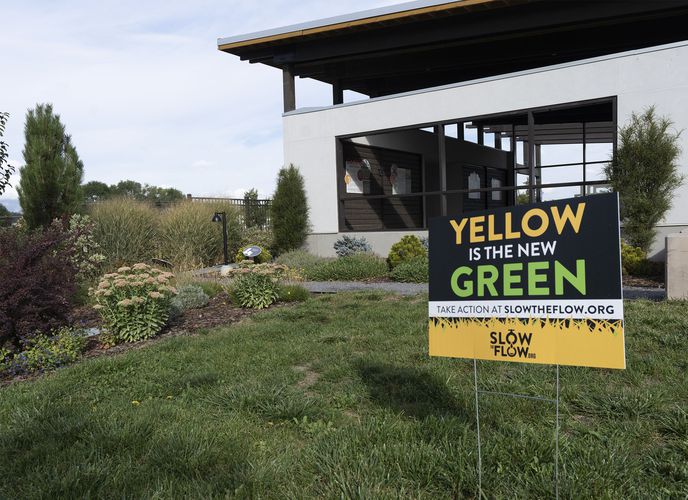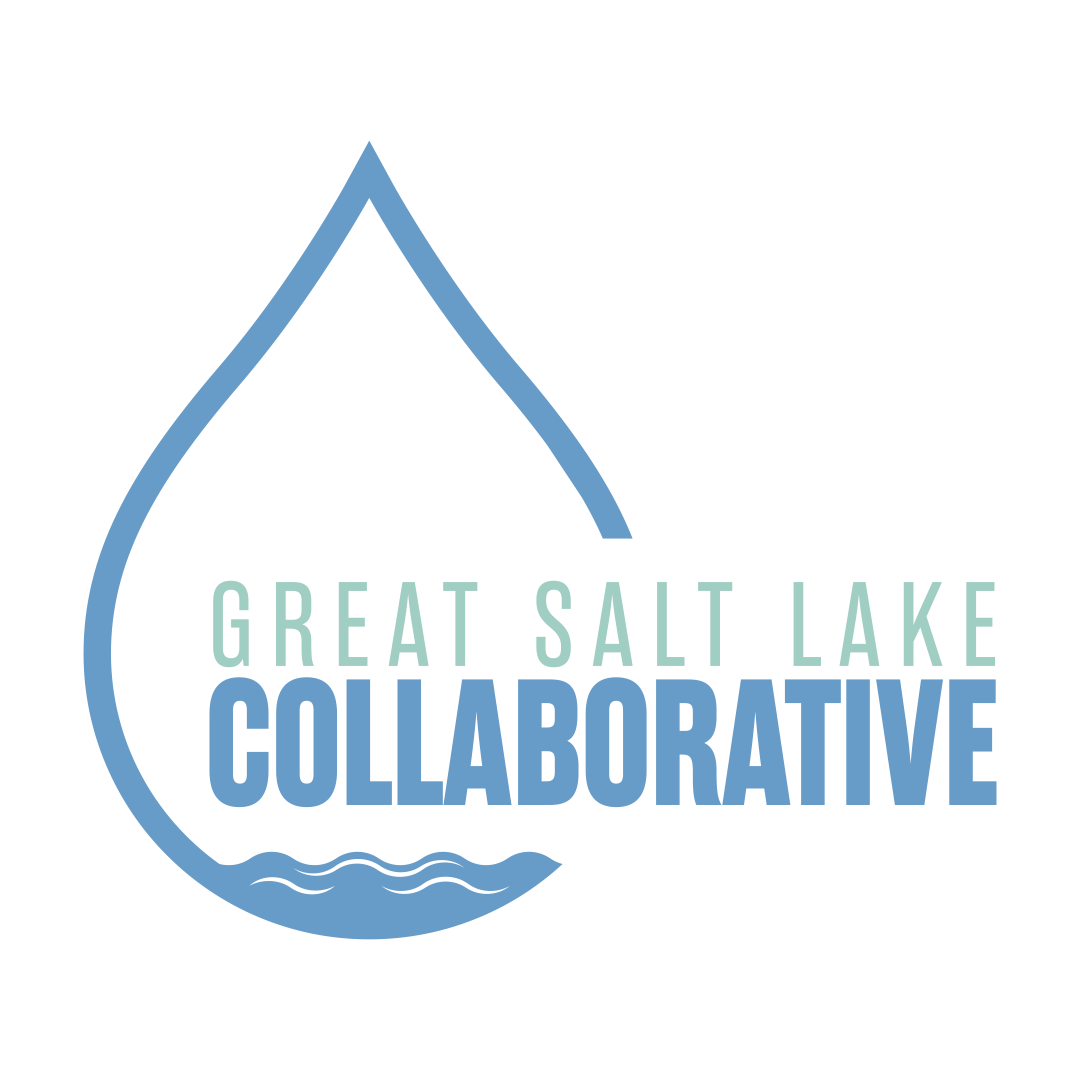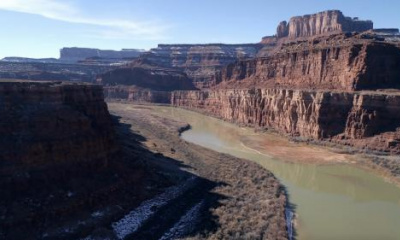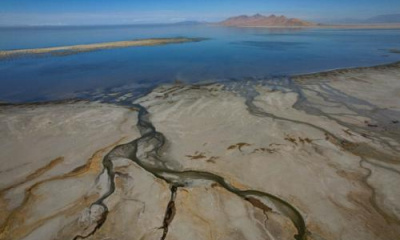Cities across the Salt Lake Valley are saving this precious resource by easing landscape rules, providing incentives and improving fixtures.
During a record-setting sweltering August, water consumption at the Jordan Valley Water Conservancy District ballooned by 12%, over last year.
As temperatures rise and growth continues, the water supplier is recording a net increase of 2% to 3% in water use in its service area, which includes many cities across the Salt Lake Valley, said Linda Townes Cook, the district’s public information manager. This runs counter to Utah’s commitment to reduce per-capita water consumption by 25% by 2025.
Jordan Valley Water has a 50-year plan that could cover water needs. The water supply could be extended for the foreseeable future if Utahns didn’t have to use water outdoors — and that’s how about 60% of the supplier’s water is used.
Given these statistics and the ongoing challenges, here is an overview of ways your Salt Lake Valley city is adapting to new water standards, climate change and growth.
Bluffdale
Bluffdale bought weather-based smart irrigation controllers in 2021 to adjust watering in city parks. That helped reduce water use by 3 million gallons in August 2021.
Portions of city-owned land such as Vintage Park, Independence Park and some trail networks also turned to xeriscaping, said Amanda Luker, communications specialist at Bluffdale. The city also plans to reuse effluent water from the Utah Data Center to water the City Main Park.
Bluffdale also requires new developments to incorporate water-efficient landscaping, with drip irrigation systems and no more than 35% grass. Planting turf in park strips and slopes is forbidden. New developments must treat and infiltrate stormwater to recharge the groundwater aquifer.
Cottonwood Heights
Cottonwood Heights modified its landscaping ordinance to require water-wise planting for new developments. Gardens for new homes should include drip irrigation systems, 3 inches of mulch in planting beds and live plants covering 50% of landscaped areas.
As for lawn, it shouldn’t cover more than 35% of the landscape for a single-family home, and 20% for a commercial lot. There are exceptions for recreational facilities.
“We wanted to make sure we still were encouraging plants for a lot of things,” said Samantha DeSeelhorst, a Cottonwood Heights city planner, “for the aesthetic quality that they bring to the community, for the habitat they provide, for the carbon uptake they provide, and because they can reduce heat in cities.”
Draper
Draper adopted a conservation plan to reduce water consumption by 25% per capita by 2025 and reached that goal this year. To do so, the city switched to smart irrigation controllers and reduced the operating days of a splash pad to three days a week.
The city also joined forces with the Localscapes program to provide lessons on water-wise landscaping and to encourage residents to trim irrigation by 25%. Draper plans to expand these educational pursuits with a new conservation garden, set to open next spring, at its Parks and Recreation building.
Mayor Troy Walker said he slashed his personal water consumption by more than half by gutting grass from this home. “We just don’t need the kind of yards that we have because we just don’t live in a place that supports it,” he said. “So I think we’ve got to change our mindset.”
Herriman
Herriman expects to conserve 10% more water than last year, said Tami Moody, the city’s public information officer. It is working on a program that would help residents determine how much water they should use for their outdoor landscaping needs based on their lot size.
Like many of the cities in the Jordan Valley Water Conservancy District, Herriman has promoted the Flip Your Strip program, which encourages residents to convert their park strip lawns into water-efficient designs in exchange for cash rebates. Another program allows residents to schedule a consultation with a professional to evaluate their landscapes for ways to increase water efficiency.
Holladay
Holladay started testing xeriscaping on street islands and other spaces and plans to use low-water turf, which requires about 30% to 40% less water than Kentucky bluegrass.
The city also trimmed its watering schedule for areas with plants to a bare minimum this summer. It also is revising its city code to reduce live plant requirements and to let residents access grants to convert their landscapes to water-efficient alternatives.
“We all need to be aware that we’re in an extreme drought. We recognize climate change as a real long-term issue that we’re all going to deal with,” Holladay Mayor Robert Dahle said. “And we all need to start thinking into the future about ways we can save water.”
Midvale
Midvale launched a new water rate structure in 2020, establishing four tiers and boosting the fee that residents pay for based on consumption.
The system was meant to fund $25 million in water infrastructure and cut future maintenance costs, said City Manager Matt Dahl, but it had the added benefit of curbing water usage.
The city allows xeriscaping and frequently promotes conservation programs from the Jordan Valley district, which offers cash incentives for water-efficient landscaping and fixtures.
Millcreek
Next on Millcreek’s action list to increase water conservation is changing its landscaping ordinance, said communications director Rita Lund. The goal is to ease residents’ access to the Central Utah Water Conservancy District’s rebate programs to move from water-guzzling plants to drought-tolerant vegetation.
The ordinance probably would recommend a list of plants that don’t require as much water to survive, spell out water priorities for maintaining tree canopies, and balance other water needs.
The incoming development, Millcreek Common, for example, won’t have a lot of grass or trees and the splash pad would tap recycled water.
Murray
About four Murray-owned properties have been converted to decrease water usage, said Russ Kakala, Murray’s public works director, and the city expects to add four or five more next year. Crews switched lawns with gravel mulch, added extra trees and installed drip irrigation systems.
Murray also works with other entities to promote these kinds of conversions — in addition to rebates to switch old toilets and showerheads for more efficient fixtures and smart sprinklers.
The city owns its own wells, and while their levels are lower than normal, Kakala said, Murray’s water supply remains in good shape.
Riverton
Riverton met its 25% water conservation goal this year. The city took initiatives such as converting some city properties, including its City Hall, to water-wise landscaping. Secondary water meters also helped achieve this goal by showing residents how much they use.
The city also found a way to improve the water quality at one of its wells. With $3 million from the American Rescue Plan, approved by Salt Lake County, Riverton funded a reverse osmosis plant at its Green Well, expected to be completed by June 2023 and which will provide around 2,000 acre-feet of culinary water a year.
The agreement required Riverton to provide the Riverbend Golf Course with water, saving county taxpayers about $100,000 a year, said Riverton Mayor Trent Staggs.
“Government sometimes doesn’t do a good enough job with innovation. But I think that we’re doing that in Riverton,” Staggs said, “and I’m seeing more and more communities in the state looking to be innovative in the way we use our water resources and that’s encouraging.”
Salt Lake City
Salt Lake City initiated its water shortage contingency plan early in 2021, encouraging residents and businesses to take voluntary conservation measures while requiring the city and institutional users to curb water use.
Utah’s capital also offers a free program to test the efficiency of sprinklers, a rain barrel program that allows residents to buy containers at cost, and this year launched a program to offer residents a grass seed that is formulated for the region and uses less water than Kentucky bluegrass.
Those efforts, combined with more public awareness of the state’s water problems, have led to major reductions in water use during peak demand, said Laura Briefer, director of the Department of Public Utilities.
“We’ve seen a lot of great conservation from the community,” she said, “and it really means that they’re stepping up to the plate to implement conservation.”
This summer, the utilities department has delivered between 125 million and 133 million gallons a day. In the past, those peaks were around 160 gallons a day.
Sandy
Sandy implemented water conservation tools in its parks and encouraged residents to follow its steps.
The city installed smart meter software that sends alerts if water use is exceeding conservation goals. Residents can also sign up for the tracker and for rebates to get smart irrigation controllers.
This year, the city established a five-tier rate system that increases water fees based on usage, in addition to recommending xeriscaping options for residences.
South Jordan
South Jordan modified its water efficiency standards for residential landscapes in May 2021. The city requires new developments to use smart irrigation controllers and provide at least 50% living plant cover in yards and park strips. It also forbids more than 25% of lawn in park strips, paths or slopes.
Daybreak’s host city has rebate programs in partnership with the Jordan Valley district, including converting park strip lawns into water-efficient designs in exchange for cash rebates. The city provides residents with rock mulch and a drip kit.
Refunds are available for turf removal in yards — if it is replaced by concrete or brick curbing, pavers, decks or patios. Residents also can get cash back by replacing old bathroom fixtures such as high-flush toilets and high-flow showerheads or faucets with water-efficient ones.
South Salt Lake
South Salt Lake says its residents have used an average of 31.25% less water this year, said Julie Taylor, communications and outreach manager for the city.
The city concentrated on increasing drought education to residential and commercial customers. It also implemented water conservation switches on city properties.
“On average Utah residents pay $500 a year [on their water bill],” Taylor said, “and they could save $170 of that by following our initiatives.”
Taylorsville
Taylorsville changed its landscape ordinance in August to make way for more water-efficient park strips. Plants should cover at least 25% of strips. Water-conserving plants, paving stones or rocks and drip irrigation systems are encouraged.
Like many cities, Taylorsville also urges residents to participate in conservation efforts from the Jordan Valley district and Localscapes.
“We’re definitely seeing an impact of the low water levels,” said Kim Horiuchi, the city’s communications director. “Everybody needs to do their part to try to conserve water.”
West Jordan
West Jordan updated its water pricing system to a five-tier model in 2020. Since then, water usage in the city dropped drastically, said Tauni Barker, the city’s director of public affairs. West Jordan saved nearly 2,200 acre-feet of water in 2021. So far this year, that number is down an additional 6%.
Residents can take advantage of rebates through the Jordan Valley district for more permanent solutions such as water-saving tools and landscaping changes.
There is no minimum requirement for residential turf. West Jordan adopted ordinances that encourage Localscapes methods.
West Valley City
West Valley City replaced its City Hall’s grass with artificial turf this year, marking the start of an easing of landscape regulations. Now, residents can install artificial turf on their front yards, along with 15% of live plant material.
In April, the city adjusted other regulations to conserve water. Indoors, every new development has to install water-efficient plumbing fixtures, and, outdoors, new constructions must add drip irrigation or bubblers except in lawn areas. Landscapes must have 50% living plants, and park strips, paths and slopes cannot have more than 25% grass.
Parks have drip irrigation systems and smart water monitoring systems, so sprinklers automatically shut off if a storm is on its way, said Sam Johnson, the city’s communications director. The city also stopped watering a golf course driving range.








